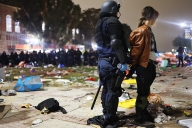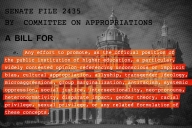You have /5 articles left.
Sign up for a free account or log in.

Dimensions/E+/Getty Images
Prospective students and their parents can find a wide range of useful information online about colleges and universities to help them decide which institutions might be the best fit. But there’s no go-to resource to assess how welcoming a college is to students from various religious backgrounds.
That’s about to change. A group of researchers at Ohio State University and North Carolina State University has crafted a tool called the Interfaith, Spiritual, Religious, and Secular Campus Climate Index, or INSPIRES, which scores higher ed institutions on their levels of religious diversity and inclusion.
Officials at 185 public, private and religiously affiliated institutions filled out extensive surveys about faith-related resources on campus, religious accommodation policies and more. Researchers analyzed the answers and scored institutions based on seven criteria, including religious accommodations, efforts to reduce bias and extracurricular and academic engagement. Campus leaders are set to receive reports of the results and personalized recommendations from researchers early next month. The institutions can then choose whether to make the information public as a resource for students and parents, in which case it’ll appear on the index website, or to keep the scores private and use them as an opportunity for introspection.
“Our goal is to help campuses become more welcoming, but ultimately this endeavor is meant to serve students and support their thriving in college,” Alyssa Rockenbach, Alumni Distinguished Graduate Professor and a professor of higher education at North Carolina State, said in an email.
Matthew Mayhew, the William Ray and Marie Adamson Flesher Professor of Educational Administration at Ohio State, said to “embrace the whole student,” instructors and administrators need a firm understanding of how well their campuses serve students of different belief systems, but, until now, they didn’t have a practical tool to gauge this.
“It feels so good to pour our energy into something that’s going to actually be used,” he said. “We’re not going to publish things in these empirical, obscure journals that nobody reads. This is something that we really feel is going to improve the lives of the people we intend to use it.”
Cody Nielsen, director of the Center for Spirituality and Social Justice at Dickinson College, called the index “revolutionary.” He also is the founder and executive director of Convergence Strategies, which seeks to improve campus climate on religion.
He noted that campuses might have programming related to interfaith dialogue, but many college leaders don’t interrogate how their policies and practices affect students from various faith backgrounds. He believes the “core issues of civil rights” related to students’ religious identities too often go unaddressed, and the index enables institutions to hold themselves accountable.
“We are not taking the religious, secular and spiritual identities of our students seriously on college campuses nationwide,” he said. “This index, if it’s done well and if its outcomes are shown well, it has the ability to make that a conversation that is no longer deniable.”
The index criteria are based on findings from the Interfaith Diversity Experiences and Attitudes Longitudinal Survey, or the IDEALS survey, launched by Rockenbach, Mayhew and Interfaith Youth Core, a nonprofit focused on fostering interfaith cooperation. The five-year project examined how students interacted with those of other belief systems and what made students of different faith backgrounds, or no faith, feel more or less at home on campuses.
A $220,469 grant from the Arthur Vining Davis Foundations—which funds projects that “advance religious, charitable, scientific, literary and educational purposes”—made the assessment process free for colleges that chose to participate, and the project has secured funding for two more years. Researchers are recruiting a new cohort of about 100 institutions to take the survey this fall.
Musbah Shaheen, a graduate research associate at Ohio State who worked on the project, said the researchers hope to have an ongoing dialogue with institutions that plan to publicize their scores on the index criteria, and those that choose to keep their scores private, and coach them on best practices.
“This is not intended to be a one-and-done assessment,” he said. “It is intended to be the beginning of a conversation within the institution as well as between us as experts in this area and the institutions as stakeholders who have demonstrated that they are interested in becoming more welcoming and interested in understanding what they’re doing on their campuses.”
Shaheen noted that many institutions lack the basic infrastructure students need to observe their faiths, such as kosher and halal meal options, dining hall hours that work for students who are fasting from sunrise to sunset for Ramadan, and convenient prayer spaces open during ritual prayer times.
The researchers listed all kinds of details campus administrators sometimes overlook, such as whether a campus’s accommodation policies for religious holidays appear on course syllabi, what kinds of religious iconography are in designated prayer rooms, whether faculty members undergo religious diversity training or whether campus events take place in religious spaces like chapels, a potential source of discomfort for atheist students.
Gordon Maples, a graduate research associate at North Carolina State who also worked on the project, said he hopes the index can not only be a resource for campus leaders, who often don’t want to touch religious topics “with a ten-foot pole,” but also for state policy makers. He noted that only about 11 states have laws that require campuses to have religious accommodation policies, and he’d like to see the index encourage state lawmakers and college administrators to develop more and better policies of this kind.
Katie Baxter, vice president of program strategy at Interfaith Youth Core, said when campuses prioritize religious diversity and inclusion, it can have a nationwide ripple effect.
“Campuses model priorities for the rest of society,” she said. “We often think about campuses as mini civil societies … that influence the communities in which they sit. Often what higher education says is important, the rest of society will follow suit.”
She also described campuses as the “perfect practice arena” for students to learn how to live in pluralistic environments and bridge differences, which “strengthens our religiously diverse democracy.”
“College campuses are places where people practice living their values and commitments and practice doing that in public and in diverse communities where not everyone shares those values and commitments,” she said.
Mayhew said college leaders are reluctant to include religion in discussions about diversity and inclusion on campuses, in part because of a fear of “dancing on that delicate line of separation of church and state.” They also don’t want to seem to be encouraging or discouraging any particular beliefs or practices.
Mayhew said religious accommodations—or a lack thereof—can affect student outcomes.
“We’ve got to stop pretending that religious identification is not a part of the student experience,” he said. “It is a major part of the student experience.”
When students feel a sense of belonging on campuses, “it’s a major driver for them to persist through college,” Mayhew said. “We can try to pretend like it’s not there … or we can start inviting the conversations in to enrich dialogue.”
Nielsen, of the Center for Spirituality and Social Justice at Dickinson, hopes the index will lead to further research on how things like kosher or halal food options affect the enrollment, retention and overall satisfaction of students who benefit from these offerings.
Even if they haven’t in the past, Rockenbach believes college leaders are starting to pay more attention to religious inclusion on campuses and are becoming more open to the kinds of issues the index addresses.
“I think higher education leaders have become increasingly attentive to the ways in which identities are multifaceted and intersectional,” she said. “If we say we care about holistic student development, then we have to think about all the ways in which race, culture, class, gender identity, sexuality, ability, religion, secularity and spirituality come together in a person’s life and also shape experiences with power, privilege and marginalization in education and society.”









